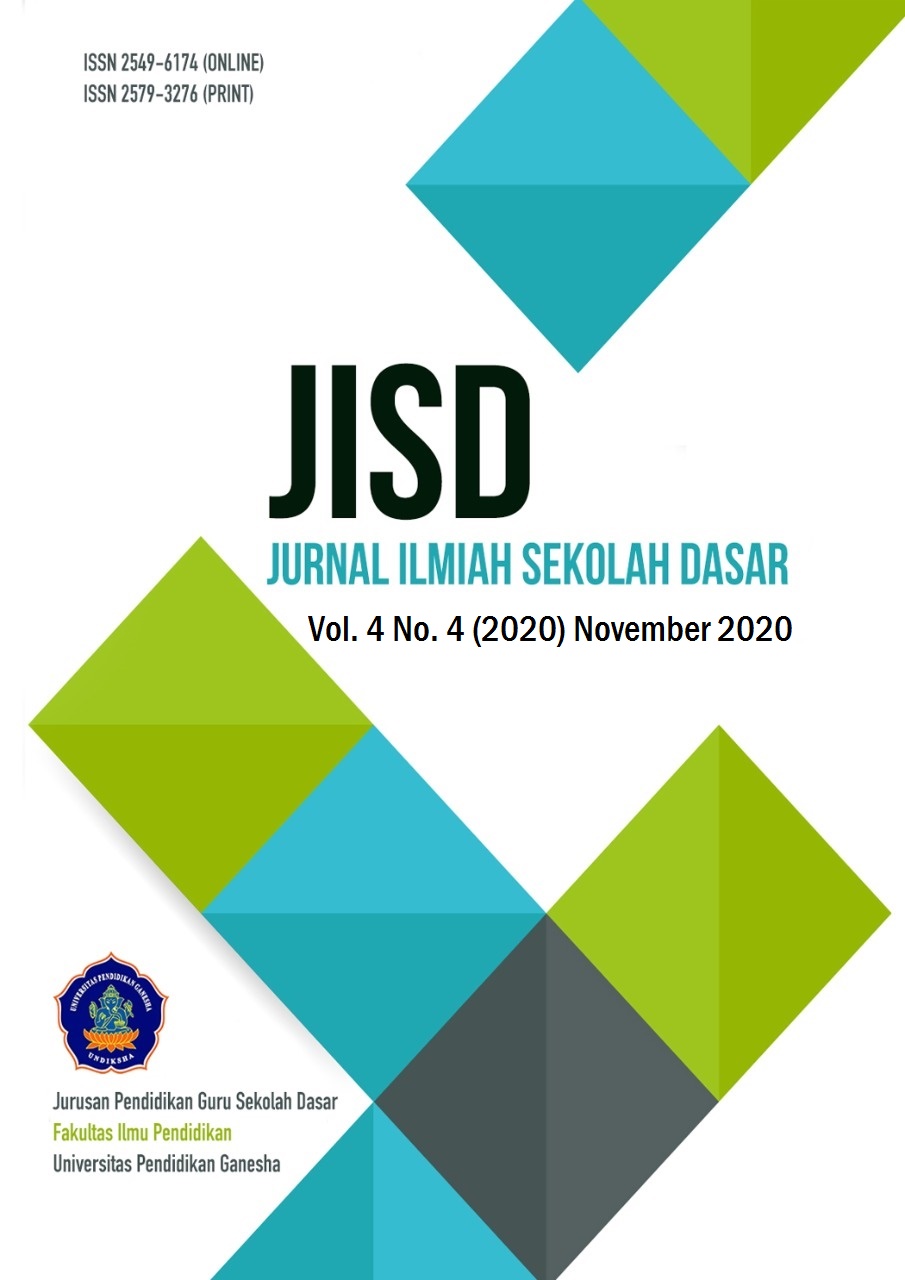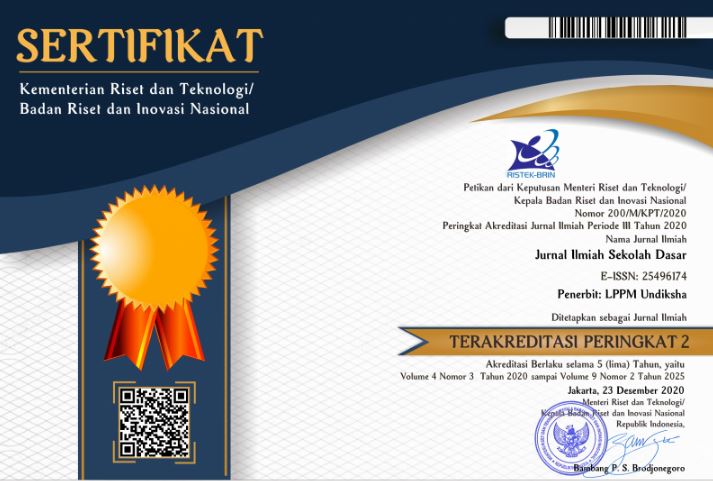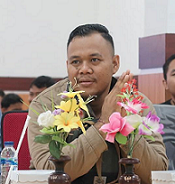Development of Learning Media for Animal Life Cycle Puzzles in Science Subjects at Fourth Grade Elementary School
DOI:
https://doi.org/10.23887/jisd.v4i4.27805Keywords:
learning media, puzzle, animal life cycleAbstract
The low activity and participation of students in learning due to the teacher's lack of learning models during the learning process. This research aims to develop learning media of animal life cycle puzzle and determine the feasibility and students’ response to the product being developed in fourth-grade elementary school. The purpose of developing animal life cycle puzzle was obtained from the results during pre-research that the teacher explained the animal life cycle material with the lecture and teacher center method, besides that the teacher also only focused on student books as a learning medium so that students looked passive in the learning process. The research method used a research and development method that has been modified by Sugiyono, which begins with the problem analysis, data collection, product design, design validation, product design revision, and product trial trials. Based on the results of the feasibility test of the learning media of animal life cycle puzzle get an average score of eligibility by a design expert team of 86, 35% with the criteria of interpretation category "Very Worthy," the average score of eligibility by the material expert team was 92.50% with the criteria for interpretation category "Very Apprpriate." The average score of eligibility by the education expert team was 96.50% by criterion category of interpretation "Very Appropriate." While the students’ response is known from a limited trial conducted on 20 students, obtained a percentage of 92.36% with the category "Very Good." Based on the results of the study, it can be concluded that the learning media of animal life cycle puzzle is very worthy and very good used in the learning process in elementary school.
References
Abidin, Z. (2017). Penerapan Pemilihan Media Pembelajaran. Edcomtech Jurnal Kajian Teknologi Pendidikan, 1(1), 9–20. http://journal2.um.ac.id/index.php/edcomtech/article/view/1784
Arsyad, A. (2017). Media Pembelajaran. In Raja Grafindo Persada.
Ayu, S. (2014). Segudang Game Edukatif Mengajar. In Diva Press.
Bujang, Halidjah, S., & Margiati, K. Y. (2014). Peningkatan Hasil Belajar Siswa Dalam Pembelajaran Ipa Menggunakan Media Realita Di Sekolah Dasar. 7, 219–232. https://www.google.com/url?sa=t&rct=j&q=&esrc=s&source=web&cd=&ved=2ahUKEwjupeTrksPtAhXHTX0KHZBdDhoQFjABegQIAxAC&url=https%3A%2F%2Fmedia.neliti.com%2Fmedia%2Fpublications%2F210480-peningkatan-hasil-belajar-siswa-dalam-pe.pdf&usg=AOvVaw0Bb00ijXd2dXZmSBSGwm1I
Cahyo. (2013). Panduan Aplikasi Teori-teori Belajar Mengajar. In Diva Press.
Desstya, D. (2017). Refleksi pendidikan IPA sekolah dasar di Indonesia (relevansi model pendidikan Paulo Freire dengan pendidikan IPA di sekolah dasar). Profesi Pendidikan Dasar, 1(1), 1–11. http://journals.ums.ac.id/index.php/ppd/article/view/2745
Dewanti, D. (2018). Pengembangan Media Pop-Up Book Untuk Pembelajaran Lingkungan Tempat Tinggalku Kelas Iv Sdn 1 Pakunden Kabupaten Ponorogo. SKRIPSI Jurusan Teknologi Pendidikan-Fakultas Ilmu Pendidikan UM. http://journal2.um.ac.id/index.php/jktp/article/view/4551
FALLA. (2019). Pengembangan Media Puzzle berbasis Make A Match Tentang Sistem Kerangka Manusia Pada Pembelajaran IPA di Sekolah Dasar. Jurnal Penelitian Pendidikan Guru Sekolah Dasar, 7(1). https://jurnalmahasiswa.unesa.ac.id/index.php/jurnal-penelitian-pgsd/article/view/27568
FATIMAH, D. (2018). Strategi Belajar dan Pembelajaran dalam Meningkatkan Keterampilan Bahasa. Pena Literasi, 1(2), 108–113. https://doi.org/10.24853/pl.1.2.108-113
Fatimah, S., & Kartika, I. (2013). Pembelajaran IPA Sekolah Dasar Berbasis Pendidikan Karakter. Jurnal Al-Bidayah, 5(2), 381–297. https://doi.org/10.14421/al-bidayah.v5i2.125
Fujiawati, F. S. (2016). Pemahaman konsep kurikulum dan pembelajaran dengan peta konsep bagi mahasiswa pendidikan seni. JPKS (Jurnal Pendidikan Dan Kajian Seni), 1(1). http://dx.doi.org/10.30870/jpks.v1i1.849
Hastuti, W. (2017). Pengaruh Media Puzzle Terhadap Hasil Belajar Ipa Konsep Daur Hidup Makhluk Hidup Murid Kelas IV SDN Nomor 25 Panaikang Kecamatan Bisappu Kabupaten Bantaeng. Pena: Jurnal Kreativitas Ilmiah Mahasiswa Unismuh, 4(1), 679–687. https://core.ac.uk/download/pdf/233601270.pdf
Husna, N., Sari, S. A., & Halim, A. (2017). Pengembangan Media Puzzle Materi Pencemaran Lingkungan di SMP Negeri 4 Banda Aceh. Jurnal Pendidikan Sains Indonesia (Indonesian Journal of Science Education), 5(1), 66–71. http://www.jurnal.unsyiah.ac.id/JPSI/article/view/8413
Iskandar, R., & Kusmayanti, I. (2018). Pendekatan Science Technology Society: Ipa Di Sekolah Dasar. Jurnal Ilmiah Pendidikan Guru Sekolah Dasar, 2(02). https://doi.org/10.31326/jipgsd.v2i02.129
Londa, A. H., Mete, Y. Y., & Sadipun, B. (2018). Penggunaan Media Puzzle untuk Meningkatkan Hasil Belajar Peserta Didik pada Pembelajaran IPA. Journal of Elementary School (JOES), 1(2), 113–120. https://doi.org/10.31539/joes.v1i2.359
Munajah, R. (2020). Penerapan Media Belajar Puzzle Untuk Meningkatkan Hasil Belajar Ipa Pada Materi Penggolongan Makhluk Hidup Siswa Kelas Iii Sekolah Dasar Negeri Mandalasari 2 Pandeglang. Jurnal Ilmiah Pendidikan Guru Sekolah Dasar, 4(1), 45–56. https://doi.org/10.31326/jipgsd.v4i1.615
Nahdi, D. S., Yonanda, D. A., & Agustin, N. F. (2018). Upaya Meningkatkan Pemahaman Konsep Siswa Melalui Penerapan Metode Demonstrasi Pada Mata Pelajaran IPA. Jurnal Cakrawala Pendas, 4(2), 9–16. http://dx.doi.org/10.31949/jcp.v4i2.1050
Nisa, S. K., Pratiwi, I. A., & Ismaya, E. A. (2020). Penerapan Model Group Investigation Berbantuan Media Puzzle untuk Meningkatkan Hasil Belajar Siswa Sekolah Dasar. Lectura: Jurnal Pendidikan, 11(2), 211–224. https://doi.org/10.31849/lectura.v11i2.4722
Nisak, R. (2011). Lebih Dari 50 Game Kreatif Untuk Aktivitas Belajar–Mengajar. Diva Press.
Panjaitan, S. (2017). Meningkatkan Hasil Belajar Ipa Melalui Media Gambar Pada Siswa Kelas Iia Sdn 78 Pekanbaru. Primary: Jurnal Pendidikan Guru Sekolah Dasar, 6(1), 252. https://doi.org/10.33578/jpfkip.v6i1.4105
Pradanti, R. . (2019). Penerapan Media Puzzle Untuk Pemahaman Materi Daur Hidup Hewan Di Sekolah Dasar Dengan Pendekatan Sains-Edutainment. Tunas Bangsa Journal, 6(1), 76–81. https://ejournal.bbg.ac.id/tunasbangsa/article/view/922
Pradanti, R. E. (2017). Pengembangan Media Puzzle Materi Daur Hidup Beberapa Hewan di Lingkungan Siswa Kelas IV SDN 1 Kalibatur Tahun Pelajaran 2016/2017. Jurnal Simki Pedagogia, 1–12. http://www.jurnal.unsyiah.ac.id/JPSI/article/view/8413
REZCI OKTAFIANTO, E. Z. A. (2018). Permainan Puzzle Lantai Terhadap Peningkatan Kemampuan Pemusatan Perhatian Anak Autis. Jurnal Pendidikan Khusus, 10(2), 1–10. https://jurnalmahasiswa.unesa.ac.id/index.php/jurnal-pendidikan-khusus/article/view/23423
Rumakhit, N. (2017). Pengembangan Media Puzzle untuk Pembelajaran Materi Mengidentifikasi Beberapa Jenis Simbiosis dan Rantai Makanan Kelas IV Sekolah Dasar Tahun 2016/2017. Jurnal Universitas Nusantara PGRI Kediri, 1(02), 1–10.
Sari, P. M. N., Parmiti, D. P., & Sukmana, A. I. W. I. Y. (2020). Hasil Belajar Matematika Melalui Model CTL Berbasis Masalah Terbuka Di SD. Jurnal Ilmiah Sekolah Dasar, 4(2), 248–256. http://dx.doi.org/10.23887/jisd.v4i2.25558
Srianis, K., Suami, N. K., & Ujianti, P. R. (2014). Penerapan Metode Bermain Puzzle Geometri Untuk Meningkatkan Perkembangan Kognitif Anak Dalam Mengenal Bentuk. E-Journal PG-PAUD, 2(1), 1–11. https://ejournal.undiksha.ac.id/index.php/JJPAUD/article/view/3533
Sugiyono, D. (2016). Metode penelitian kuantitatif dan R&D. In Bandung: Alfabeta.
Sutiyem, S. D. N. (2018). Peningkatan Hasil Belajar Ipa Materi Fungsi Alat Tubuh Manusia Melalui Puzzles Picture Game Pada Siswa Kelas Iv Sekolah Dasar. Surya Buana Pendidikan, 1(1), 66–73.
Tafonao, T. (2018). Peranan media pembelajaran dalam meningkatkan minat belajar mahasiswa. Jurnal Komunikasi Pendidikan, 2(2), 103–114.
Thobroni. (2015). Belajar dan Pembelajaran. Yogyakarta: Ar-Ruzz Media.
Trimantara, H., & Mulya, N. (2019). Mengembangkan Bahasa Anak Usia 4-5 Tahun Melalui Alat Permainan Edukatif Puzzle. Al-Athfaal: Jurnal Ilmiah Pendidikan Anak Usia Dini, 2(1), 25–34. https://doi.org/10.24042/ajipaud.v2i1.4553
Utami, Y. S. (2020). Penggunaan Media Gambar Untuk Meningkatkan Hasil Belajar Siswa Dalam Pembelajaran Ipa. Jurnal Pendidikan Dan Konseling (JPDK), 1(2), 122–127. https://doi.org/10.31004/jpdk.v1i2.607
Widiana, I. W., Rendra, N. T., & Wulantari, N. W. (2019). Media Pembelajaran Puzzle Untuk Meningkatkan Hasil Belajar Siswa Kelas Iv Pada Kompetensi Pengetahuan Ipa. Indonesian Journal Of Educational Research and Review, 2(3), 354–362. http://dx.doi.org/10.23887/ijerr.v2i3.22563.g14041
Wilis, R. (n.d.). Meningkatkan Hasil Belajar Ipa Siswa Materi Daur Hidup Hewan Dengan Menggunakan Media Gambar Di Kelas Iv Sdn 012 Simangambat Kecamatan Siabu Kabupaten Mandailing Natal. JGK (Jurnal Guru Kita), 1(4), 80–85. https://doi.org/https://doi.org/10.24114/jgk.v1i4.9408
Yulianty, R. (2016). P. yang M. K. A. J. L. A. (2016). Permainan yang Meningkatkan Kecerdasan Anak. Laskar Aksara.
Downloads
Published
How to Cite
Issue
Section
License
Authors who publish with the Journal Ilmiah Sekolah Dasar agree to the following terms:
- Authors retain copyright and grant the journal the right of first publication with the work simultaneously licensed under a Creative Commons Attribution License (CC BY-SA 4.0) that allows others to share the work with an acknowledgment of the work's authorship and initial publication in this journal.
- Authors are able to enter into separate, additional contractual arrangements for the non-exclusive distribution of the journal's published version of the work (e.g., post it to an institutional repository or publish it in a book), with an acknowledgment of its initial publication in this journal.
- Authors are permitted and encouraged to post their work online (e.g., in institutional repositories or on their website) prior to and during the submission process, as it can lead to productive exchanges, as well as earlier and greater citation of published work. (See The Effect of Open Access)











